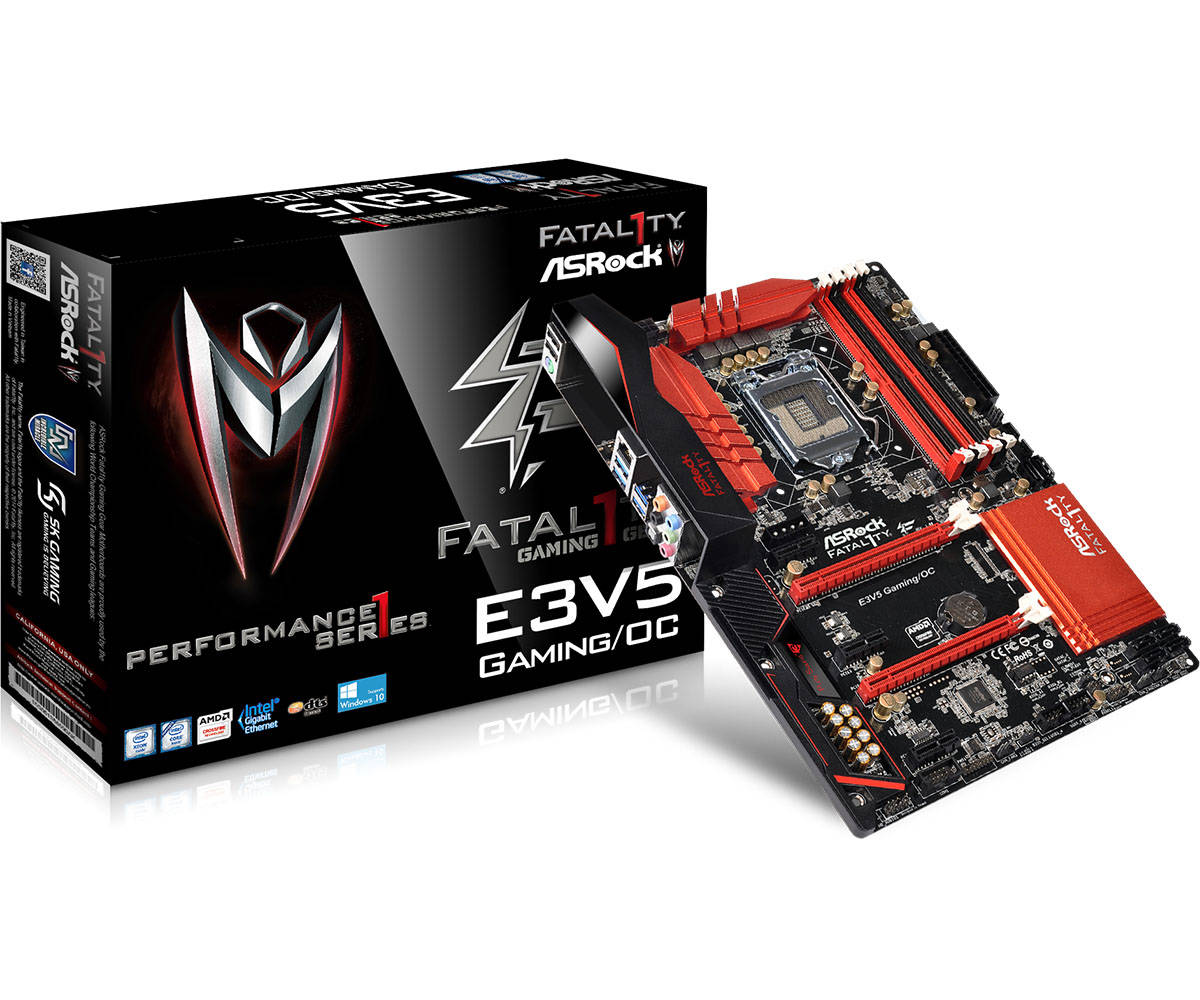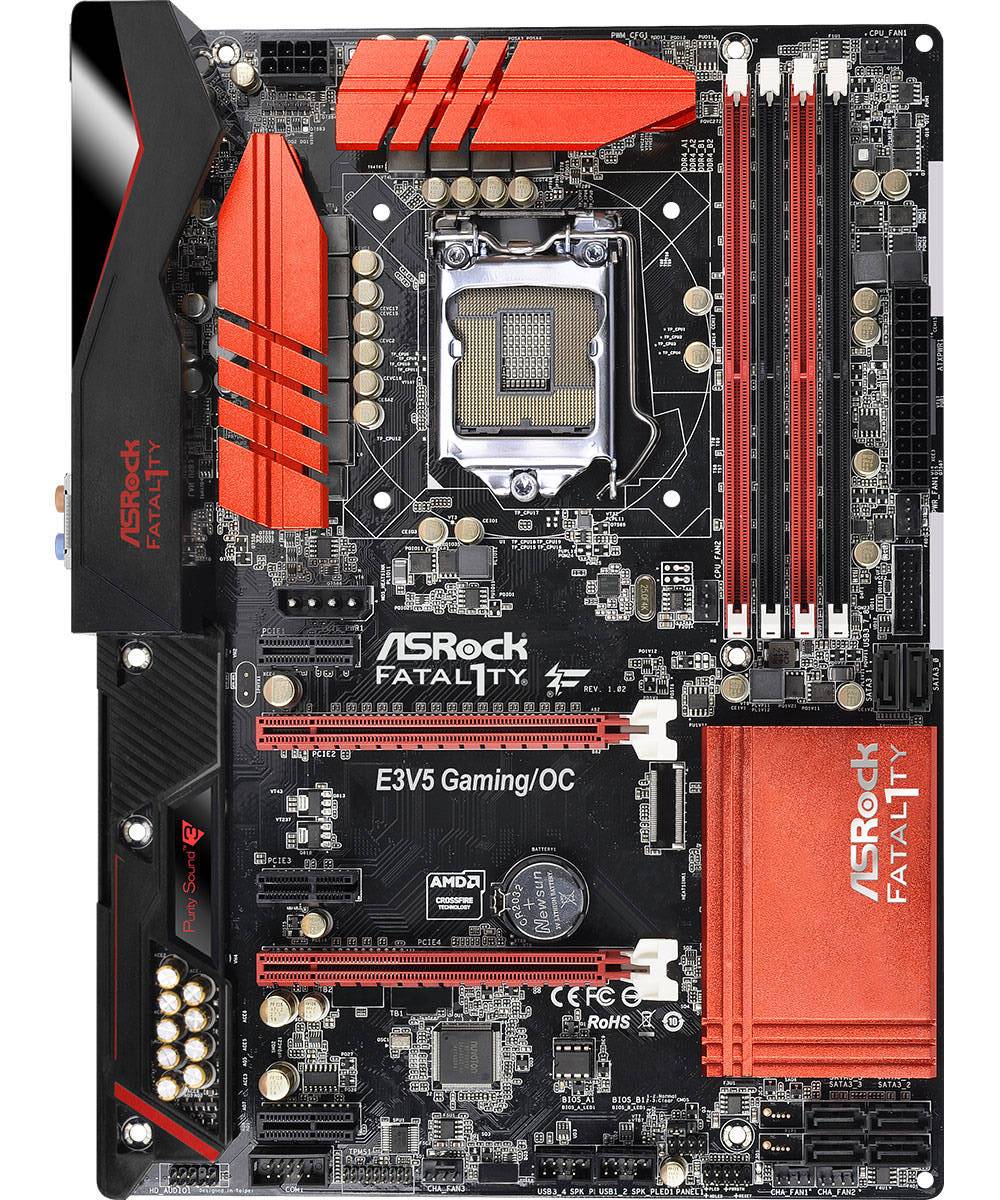The ASRock E3V5 Performance Gaming (C232) Motherboard Review
by Ian Cutress on May 4, 2016 9:00 AM EST- Posted in
- Motherboards
- ASRock
- Xeon
- Skylake
- Intel C232
ASRock E3V5 Performance Gaming Conclusion
There are several ways to define feature points in a product. I like to think that they fall into three levels: the first being the absolute ‘must-use’ if you buy the product. Things in this category include integrated 10 gigabit Ethernet, because chances are you won’t buy a 10GbE motherboard and not use it. The middle level is the ‘it’s there’ portion of features that may or may not be used, such as PCIe slots or video outputs. These components don’t necessarily make a motherboard a must-have, but their presence (at low cost) typically is beneficial if a user needs them. The third category is the ‘why did they include that’, which goes for feature sets that are over-priced or almost impossible to use together. Normally I’d point to bad PCIe layouts, over the top power delivery on a mid-range board, or the disastrous combination of SATA Express/M.2 we had in 2014/2015.
Out of the feature-set, these are further sub-divided into passive (‘it’s there and I don’t need to do anything’) and active (‘it has to be used to get a benefit’). So under passive comes power delivery, audio arrangements, or DRAM routing, then under active comes things like WiFi or BIOS/software features.
The reason I’ve started the conclusion to the Performance Gaming with this set of definitions is because both passive and active features increase the cost to the motherboard design, but active features are more easily noted. A typical user who does not overclock is not necessarily going to feel the benefit every day of an over-engineered power delivery, but they have already paid to have it. However if someone needs USB 3.1 or vendor-supplied fan controls, that’s something that has associated cost and is easily linked to the price of the product.
The ASRock E3V5 Performance Gaming isn’t a product that boasts a ‘must-use’ feature. Ever since the overclocking element was removed, the improved power delivery falls somewhat to the wayside but adds in cost. There are no additional controllers due to PCIe arrangements, and we only have a single PCIe slot from the processor due to the C232 chipset limitations. The biggest plus point for the motherboard is support for the Skylake E3-1200 V5 family of Xeons as well as ECC memory and the upgraded graphical BIOS which is rarely found on a Xeon focused motherboard. However, ASRock doesn’t provide fan controls in the OS software, and makes it spectacularly annoying to install ASRock related features from the normal software stack.
Performance is middling for a non-MultiCore Turbo motherboard, with a plus on power delivery and DPC Latency, a medium POST time, but not so great USB performance or audio. The audio result is surprising, given the extra engineering with the Realtek ALC1150 codec. One other hardware plus point is the Intel network controller, which we are starting to see on motherboards south of $150.
For the $143 current cost on Newegg, here is a very basic board with improved power delivery and a nice BIOS that supports Skylake based Xeons. It seems like a nice board to look at as well, despite the fact that it will probably end up in a closed case. If you need something simple that does the Xeon thing with a single discrete GPU, the E3V5 Performance Gaming has you covered on most fronts, although the lack of fan control in Windows is odd. I’ll need to explore a few more C232 motherboards to find out where this one stands in the larger scheme of things, but for non-Xeon users looking for a board in this price range, I’ll point back to our previous review on the MSI Z170A SLI PLUS which handily comes out ahead.
Other 100-Series and C232/C236 Motherboard Reviews:
Prices Correct at time of each review
$500: The GIGABYTE Z170X-Gaming G1 Review [link]
$500: The ASUS Maximus VIII Extreme Review [link]
$370: The GIGABYTE Server MW31-SP0 (C236) Review [link]
$250: The ASUS Maximus VIII Impact Review [link]
$240: The ASRock Z170 Extreme7+ Review [link]
$230: The MSI Z170 Gaming M7 Review [link]
$208: The GIGABYTE Z170-UD5 TH Review [link]
$165: The ASUS Z170-A Review [link]
$143: The ASRock E3V5 Performance Gaming (C232) Review [this review]
$130: The MSI Z170A SLI PLUS Review [link]
$125: The Supermicro C7H170-M Review [link]












22 Comments
View All Comments
DanNeely - Wednesday, May 4, 2016 - link
The USB 2/3 information in the table on the first page doesn't appear consistent between C236/C232 and Q170/B150. Is it correct? eg the latter lists 10/14 USB3/2 ports reflecting support for 14 USB ports, of which up to 10 can be converted into USB3 ports by combining them with a high speed IO lane from the chipset. The C236 lists 10/4 ports; which is the distribution you'd get if using 10 HSIO lanes to make the max number of USB3 ports. However putting it in the table like that implies that the 10 lanes are locked into USB3; which strikes me as odd, since for server/workstation uses SATA/PCIe/m.2 seem like they'd be more generally useful than lots of USB3.close - Wednesday, May 4, 2016 - link
Apparently you can slap "performance-gaming" even on a product based on a cut down B150 with Xeon support. This is one way to devalue this kind of branding.BurntMyBacon - Wednesday, May 4, 2016 - link
@close: "Apparently you can slap "performance-gaming" even on a product based on a cut down B150 with Xeon support. This is one way to devalue this kind of branding."The mentality is a little different than that. They think you can slap "performance-gaming" on anything with overclocking features. Putting aside the fact that these are two different markets, they had the unfortunate lack of foresight to predict that Intel would shut the new fangled Xeon overclocking features down. Now the board no longer fits even their definition of "performance-gaming", but their is no way for the average consumer to know that. They should have rebranded the product. Instead, they've done exactly as you said, devalued the branding.
close - Wednesday, May 4, 2016 - link
To be honest I only spotted the "OC" part after I posted the comment. Waiting for the "Gaming-Performance-OC-Megatron stick in the mud" edition.xKrNMBoYx - Monday, May 9, 2016 - link
Actually I have this motherboard and a E3 1275 V5. You can still OC on the very first BIOS (v1) or on the beta BIOS 1.3. Enjoying a 4.5GHz Skylake Xeon.Zarok001 - Wednesday, December 28, 2016 - link
Can I still download this bios anywhere. I was told that this overclocking still works and now im sitting here with a GTX 1070 and a locked Intel Xeon E3-1245v5, i mean it boosts up to 3.9Ghz but i would love to overclock it.BrokenCrayons - Thursday, May 5, 2016 - link
Let's face it, the branding doesn't have much value anyway at this point regardless of what ASRock does to it. It's silly to stick numbers into words these days as is done with the 1 in the word Fatal1ty. That just comes off as 1990's era childish. "Performance-gaming" is just marketing speak that is intended to appeal to a targeted audience of potential buyers in order to enable an exchange of money and products. The same is true of the color scheme the vendor selected, some of the "features" of the motherboard itself, and licensing the use of a now unknown crusty old "pro gamer." In order to charge a price premium, companies have to ensure their products fit the buyer both in actual capabilities, perceived benefits, and emotional appeal. It's pretty safe to dismiss the majority of ASRock's marketing materials (and probably for the best in all product purchases in order to make a rational decision) so a potential buyer can assess the actual benefits the product offers.And yes, I've been accused of being a buzzkill more than once. :)
Gunbuster - Wednesday, May 4, 2016 - link
So this is the weird byproduct of Xeon overclocking being discovered? But since Intel slapped down all the board manufacturers this is now an effectively useless product?jasonelmore - Wednesday, May 4, 2016 - link
Intel just doesnt wanna sell the new gen CPU's with OC and ECC..tons of people wanna build a skylake nas box with ECC for freenas, but intel is making it very hard to do this without buying a integrated board with a bunch of atom cores. We want the OC for VM performance, while still keeping ECC
StrangerGuy - Thursday, May 5, 2016 - link
I for one, is still amazed that people expects overclocking free lunches from Intel in year 2016 like they are still living in 2007.